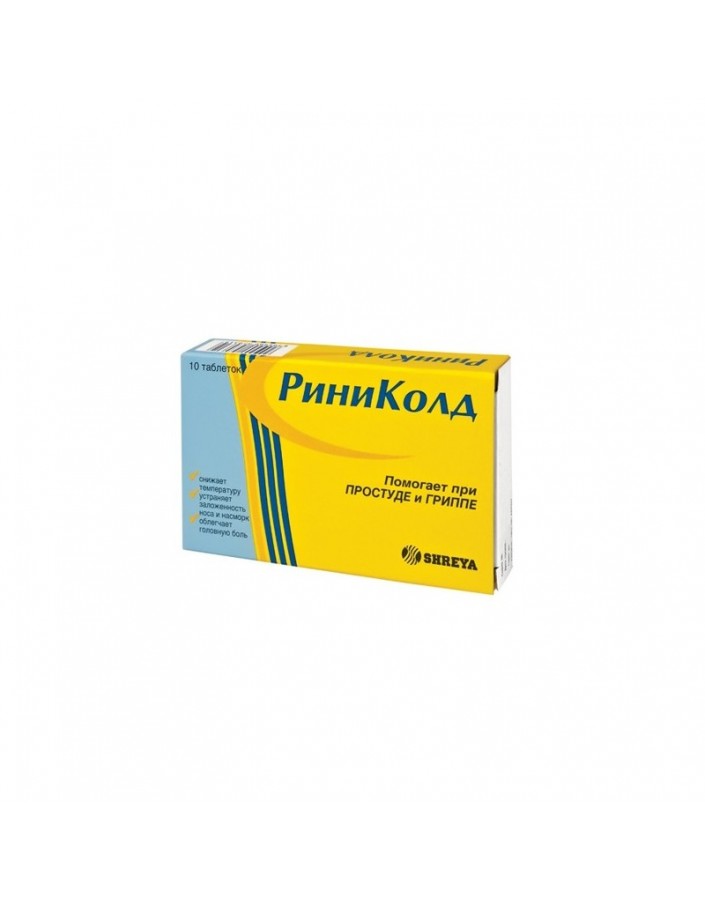



RINICOLD PILLS - 10 tabs

Security policy (edit with Customer reassurance module)

Delivery policy (edit with Customer reassurance module)

Return policy (edit with Customer reassurance module)
1 pill contains Paracetamol 500 mg, caffeine 30 mg, phenylephrine hydrochloride 10 mg, chlorpheniramine maleate 2 mg, as well as excipients (MCC, starch, talc, Magnesium stearate, sodium starch glycolate, gelatin, polyvinyl pyrrolidone, methyl paraben, propyl paraben); in a blister strip packaging 10 pcs., in a cardboard bundle 1 pack.
It has antipyretic and analgesic effect (paracetamol); narrows blood vessels, eliminates nasal congestion and reduces nasal discharge (phenylephrine); has anti-allergic and anti-edematous effect, reduces vascular permeability, eliminates swelling and hyperemia of the nasal mucosa, suppresses the symptoms of allergic rhinitis, facilitates breathing (chlorpheniramine); stimulates the central nervous system, reduces fatigue and drowsiness, increases mental and physical performance (caffeine).
Catarrhal diseases associated with a runny nose, nasal congestion, headache, fever, chills, pain in the joints and muscles.
Hypersensitivity, simultaneous use of drugs containing substances that are part of Rinicold, tricyclic antidepressants, MAO inhibitors, beta-blockers; pregnancy, breastfeeding, age up to 6 years.
Insidefor adults - 1-2 tablets. every 4-6 hours. Maximum daily dose - 8 tab.Children over 6 years old - 1 tab. every 4–6 hours (no more than 4 times a day) for 5 days (no more).
Contraindicated. At the time of treatment should stop breastfeeding.
Enhances the effects of MAO inhibitors, sedatives, ethanol. Antidepressants, anti-parkinsonian and antipsychotic drugs, incl. Phenothiazine derivatives increase the risk of urinary retention, dry mouth, and constipation. Glucocorticoids increase the risk of developing glaucoma. Paracetamol lowers the effectiveness of diuretics.The combination of chlorpheniramine with MAO inhibitors or furazolidone may be accompanied by hypertensive crisis, agitation, hyperpyrexia. Tricyclic antidepressants increase the sympathomimetic effect, halothane increases the risk of ventricular arrhythmias. Lowers the hypotensive effect of guanethidine, which, in turn, enhances the alpha-adrenostimuliruyuschuyu activity of phenylephrine.
Overdose is usually caused by paracetamol.
Symptoms: pallor of the skin, anorexia, nausea, vomiting, hepatonecrosis, increased activity of hepatic transaminases, an increase in prothrombin time.
Treatment: gastric lavage, the appointment of Activated carbon, symptomatic therapy.
Caution is prescribed for deficiency of glucose-6-phosphate dehydrogenase, blood diseases, hepatic and / or renal failure, angle-closure glaucoma, prostate adenoma, Gilbert syndrome, hypertension, thyroid disease, diabetes mellitus, bronchial asthma. During treatment should refrain from taking alcohol. Use with caution while working drivers of vehicles and people whose profession is associated with increased concentration of attention.
When taken in recommended doses, side effects are rare.
From the nervous system and sensory organs: dizziness, headache, sleep disturbance, irritability.
On the part of the digestive tract: nausea, dry mouth.
Other: allergic reactions.